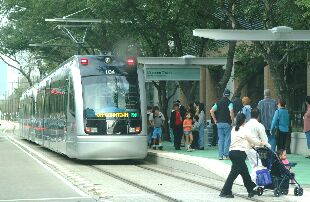
Light Rail Now! can be contacted at: Light Rail Now! |
Note: The following commentary has been slightly adapted from an op-ed
published in the Viewpoints section of the Houston Chronicle of 13 Nov. 2004.
See: Houston finally has rail transit. Trains carry 30,000 passenger-trips a day on the Main Street line. The Metropolitan Transit Authority's applications for federal money to build extensions are in. So why are Metro's new leaders rethinking rail once again? For three days in late October, Metro board members, a panel of experts, elected officials, and community representatives listened as rail suppliers presented a dozen different rail technologies. The purpose of the forum was to verify that decisions approved by the previous Metro board and Houston voters last November really are the best we can do to take Houston into the 22nd century. In other words, have we chosen a technology that will offer the greatest service safety, accessibility, frequency, and speed for the cost? Light rail transit (LRT) is the most popular rail transit technology in the United States, with over 20 systems in operation, and another three under construction. On Nov. 2, voters in Phoenix and Denver approved light rail expansion. A light rail line at ground level is less than half as expensive as any other urban rail transit option. That's critical: the Federal Transit Administration (FTA) awards funding based on cost effectiveness; a more expensive system is only justified if it attracts significantly more passengers. The leading argument against light rail is the number of crashes between autos and rail on the Main Street line. But most of the light rail accidents have been minor fender-benders like those that happen daily on Houston freeways. ironically, figures reported by transportation reporter Lucas Wall in the Chronicle suggest that the light rail has actually reduced the number of accidents on the line. Metro's studies for light rail extensions include design features like signalized left turn lanes that will make future lines safer than Main Street.
By contrast, alternate technologies like people movers, mini-metros, and monorails require the entire route to be separated, either by elevating it, putting it underground, or fencing it off. That's costly. The question is whether the benefits warrant the expense. Total separation allows for automated, driverless operation, but the benefits of this are often not as dramatic as touted. The labor costs saved by eliminating drivers may be offset by higher maintenance expense, and the closely spaced trains promised by automation don't always materialize. For example, the fully computerized BART system in San Francisco can barely operate a train every two minutes; meanwhile, Toronto runs streetcars in the same lanes as automobiles just as frequently. That's a lot of capacity; two-car light rail trains running every three minutes – the design capacity of the Main Street line – can carry 8,000 people an hour in each direction. Higher top speeds offered by grade separation (be it with light rail or another technology) also have limited benefits in practice. Only about half the travel time on the Main Street line consists of travel; the rest is spent in stations. Thus, doubling the top speed on Main Street would only reduce the travel time by a quarter. On the planned North Hardy route, passing tracks at stations will allow future express trains to skip some stations, offering greatly reduced travel time without much additional cost. In any case, riders seem to care more about predictable travel times than overall speed. Transit planners across the United States have concluded that the benefits of extensive grade separation are not worth the cost except in very dense cities like New York. Elsewhere, surface light rail delivers comparable benefits at a fraction of the cost. Light rail can also bring benefits that other technologies cannot. As the new restaurants and lofts along and near the Main Street line show, light rail can not only blend into a neighborhood but actually improve it. The same cannot be said for an elevated train. Elevated guideways look sleek in computer renderings, but are less elegant, with thickened columns, electric conduits and emergency walkways. But it is the stations that are the real problems: imagine a building, 50 feet wide and 200 feet long, suspended over a city street, with four escalators and two elevators to the sidewalks below. That is obtrusive in downtown, let alone in a residential neighborhood.
The reality is that elevated transit systems are best placed in existing corridors like rail lines or freeways. That is fine when those corridors are where the people are; but that's not generally the case. On Fulton, the alternative to street-running rail serving the neighborhood would be an elevated line in the middle of the Hardy Toll Road. That would serve mainly industrial areas while bypassing neighborhoods and destinations like Northline Mall entirely. There are corridors in Houston – like Westpark – that might be well suited for elevated lines. But that can be done with light rail; using a different technology there would require either a second north-south line through downtown – duplicating the investment we have already made at higher cost – or make riders transfer to light rail or bus to get downtown. Sticking with a single technology will result in a more convenient, more flexible system. It will also reduce maintenance costs. Ultimately, Metro isn't facing a technology problem at all. Passengers don't care about automation or magnetic levitation or grade separation. They care whether the ride is comfortable and reasonably fast, how long they wait and whether they have to transfer and, most importantly, if they can get where they want to go. Metro's mission is to meet those needs at the lowest cost, not to reinvent the wheel.
Spieler is a structural engineer, a transportation writer for Cite magazine, and a member of the Citizens' Transportation Coalition. He can be reached at cspieler@kccs.us. Light Rail Now! website Updated 2004/12/13 |
|
|
|